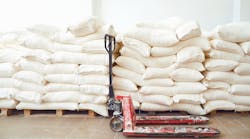Powders and bulk solids aren’t always the first ingredients noticed in the food & beverage processing world, but they do represent the foundation for a variety of food products, from baked goods, beverages and seasonings or flavoring mixes.
No matter what their purpose in a plant, improper handling of these materials can have disastrous effects, ranging from poor quality and safety of the final product to explosive destruction of equipment or entire facilities. Food & beverage processors face these challenges on a daily basis.
One of the most significant challenges in handling powders and bulk solids is managing the flow of materials. Crucial to finding success in this arena is to fully understand the material being handled, explained Eric Maynard, vice president of Jenike & Johanson Inc. in a presentation at the International Powder & Bulk Solids Conference & Exhibition in Rosemont, Ill., last month.
Solids behave differently than liquids, he said, but flow problems are preventable with the proper design and tactics. In systems not designed with the material type in mind, powders and bulk solids can easily stick together, which can lead to bridging, ratholing and other blockages. Any of these situations can delay production, damage equipment or create safety hazards for employees.
Processors must consider material factors such as humidity, temperature and particle size, as well as the flow pattern of the equipment handling the material.
To that end, proper equipment design can ensure the smooth flow of materials. Vibration or air flow can help keep powders and bulk solids moving through pipes and along conveyors. Others may use special coatings or material to keep those ingredients in motion.
Maintaining product quality and consistency can be a challenge in handling certain powders and bulk solids. Degradation can impact the flavor, texture and nutritional value of the final product, and segregation, in which variations in particle size cause the mixture to separate during distribution, can impact performance down the line.
Where hoppers are involved in the transfer of these materials, Maynard explained the importance of choosing the proper slope for the cone. Funnel-flow cones, which dispense material via gravity at a 45-degree slope, work best for coarse particles that are free-flowing and non-degrading. However, if the materials are in a mixture that is sensitive to segregation of the different ingredients, a funnel-flow cone should be avoided.
Mass-flow hoppers feature a slope of 60 degrees or greater, and are designed for cohesive solids, fine powders, degradable materials and blends that typically segregate when dispensed into the hopper or silo. Maynard added that bridging could still occur if the outlet was not sized properly to handle the materials.
There are solutions
Processors experiencing any of these issues have options to remedy the situation, says Kevin Solofra, laboratory manager for Kansas State University Bulk Solids Innovation Center in Salina, Kan.
“The choice between upgrading or retrofitting older equipment for new purposes versus all-new systems for production expansion is a top challenge,” he says. And, similar to most issues the industry faces, Solofra says resources stand as the biggest hurdle to overcoming these challenges. Having enough people and resources to get the job done within the allotted time remains a tough nut to crack for many processors.
In addition to these challenges, handling powders and bulk solids in food processing also presents safety risks. These ingredients can be explosive, which can lead to serious injuries, equipment damage or even large-scale disasters. Attention to these risks and how to mitigate them are crucial during design, setup and operation of the equipment used to handle powders.
During operation, processors must follow strict safety protocols and implement best practices. Dust collection systems can minimize the buildup of combustible dust, and special safety measures must be taken to avoid electrical malfunctions or static-electricity buildup as well.
Handling powders and bulk solids in food and beverage plants requires a careful balance among safety, quality and efficiency. Smooth, consistent flow of materials is imperative, but not at the expense of product quality and plant and product safety. Investment in employee training and development can give employees the knowledge and skills necessary to handle powders and bulk solids safely and efficiently.
Workers can stand as the first line of defense in preventing problems from developing into disasters. Meanwhile, careful design, monitoring and control of the powders/bulk solids handling operations can help processors produce high-quality products safely and efficiently.


